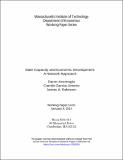State Capacity and Economic Development: A Network Approach
Author(s)
Acemoglu, Daron; Garcia-Jimeno, Camilo; Robinson, James A.
DownloadAcemoglu14-01.pdf (1.821Mb)
Metadata
Show full item recordAbstract
We study the direct and spillover effects of local state capacity using the network of Colombian municipalities. We model the determination of local and national state capacity as a network game in which each municipality, anticipating the choices and spillovers created by other municipalities and the decisions of the national government, invests in local state capacity and the national government chooses the presence of the national state across municipalities to maximize its own payoff. We then estimate the parameters of this model using reduced-form instrumental variables techniques and structurally (using GMM, simulated GMM or maximum likelihood). To do so we exploit both the structure of the network of municipalities, which determines which municipalities create spillovers on others, and the historical roots of local state capacity as the source of exogenous variation. These historical instruments are related to the presence of colonial royal roads and local presence of the colonial state in the 18th century, factors which we argue are unrelated to current provision of public goods and prosperity except through their impact on their own and neighbors’ local state capacity. Our estimates of the effects of state presence on prosperity are large and also indicate that state capacity decisions are strategic complements across municipalities. As a result, we find that bringing all municipalities below median state capacity to the median, without taking into account equilibrium responses of other municipalities, would increase the median fraction of the population above poverty from 57% to 60%. Approximately 57% of this is due to direct effects and 43% to spillovers. However, if we take the equilibrium response of other municipalities into account, the median would instead increase to 68%, a sizable change driven by equilibrium network effects.
Date issued
2014-01-08Publisher
Cambridge, MA: Department of Economics, Massachusetts Institute of Technology
Series/Report no.
Working paper, Massachusetts Institute of Technology, Dept. of Economics;14-01
Keywords
Colombia, economic development, networks, public goods, state capacity